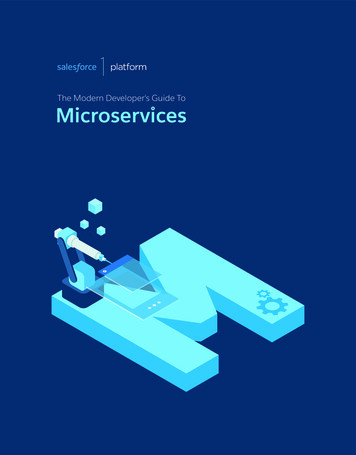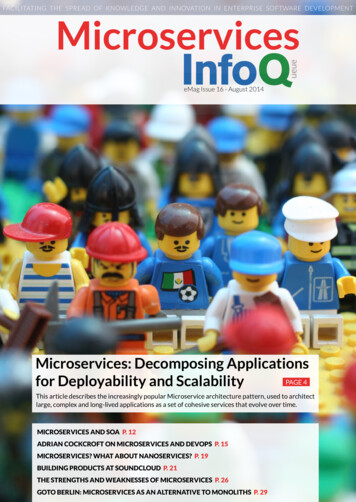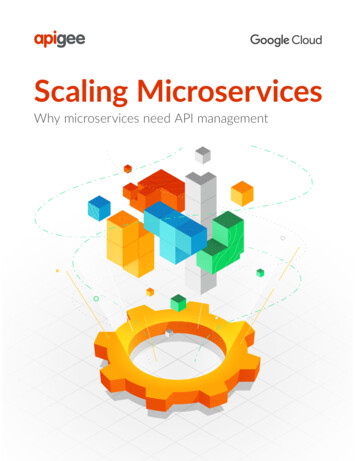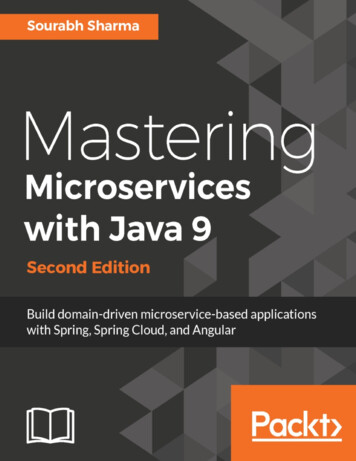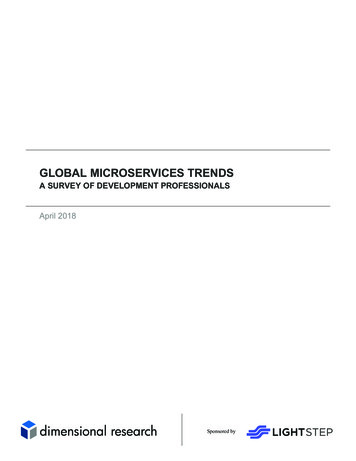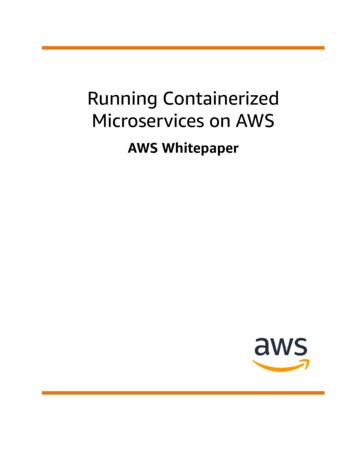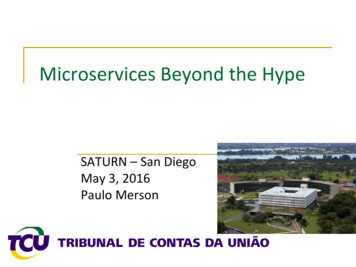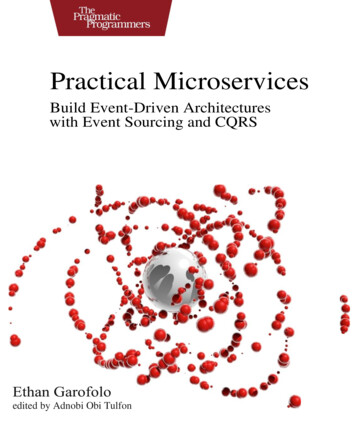
Transcription
Extracted from:Practical MicroservicesBuild Event-Driven Architectureswith Event Sourcing and CQRSThis PDF file contains pages extracted from Practical Microservices, published bythe Pragmatic Bookshelf. For more information or to purchase a paperback orPDF copy, please visit http://www.pragprog.com.Note: This extract contains some colored text (particularly in code listing). Thisis available only in online versions of the books. The printed versions are blackand white. Pagination might vary between the online and printed versions; thecontent is otherwise identical.Copyright 2020 The Pragmatic Programmers, LLC.All rights reserved.No part of this publication may be reproduced, stored in a retrieval system, or transmitted,in any form, or by any means, electronic, mechanical, photocopying, recording, or otherwise,without the prior consent of the publisher.The Pragmatic BookshelfRaleigh, North Carolina
Practical MicroservicesBuild Event-Driven Architectureswith Event Sourcing and CQRSEthan GarofoloThe Pragmatic BookshelfRaleigh, North Carolina
Many of the designations used by manufacturers and sellers to distinguish their productsare claimed as trademarks. Where those designations appear in this book, and The PragmaticProgrammers, LLC was aware of a trademark claim, the designations have been printed ininitial capital letters or in all capitals. The Pragmatic Starter Kit, The Pragmatic Programmer,Pragmatic Programming, Pragmatic Bookshelf, PragProg and the linking g device are trademarks of The Pragmatic Programmers, LLC.Every precaution was taken in the preparation of this book. However, the publisher assumesno responsibility for errors or omissions, or for damages that may result from the use ofinformation (including program listings) contained herein.Our Pragmatic books, screencasts, and audio books can help you and your team createbetter software and have more fun. Visit us at https://pragprog.com.The team that produced this book includes:Publisher: Andy HuntVP of Operations: Janet FurlowExecutive Editor: Dave RankinDevelopment Editor: Adaobi Obi TultonCopy Editor: Jasmine KwitynIndexing: Potomac Indexing, LLCLayout: Gilson GraphicsFor sales, volume licensing, and support, please contact support@pragprog.com.For international rights, please contact rights@pragprog.com.Copyright 2020 The Pragmatic Programmers, LLC.All rights reserved. No part of this publication may be reproduced, stored in a retrieval system,or transmitted, in any form, or by any means, electronic, mechanical, photocopying, recording,or otherwise, without the prior consent of the publisher.ISBN-13: 978-1-68050-645-7Encoded using the finest acid-free high-entropy binary digits.Book version: P1.0—April 2020
For Julie, Sofia, Eva, and Angelo—you are life and joy
IntroductionHere’s the deal, y’all—software is easy to write, but it’s hard to change.If you’re reading this book, then chances are you can write code. Maybe you’rea software developer, a technical lead, an architect, or a CTO. You’ve shippedweb-based applications that have provided a lot of business value to thepeople who paid you to do that. You’re good at what you do, but somethingkeeps happening with your projects, where productivity slows down despitespending more money and hiring more people. You want to learn how to fixthat, and maybe you’ve heard about microservices and are wondering howto build them.Telling a Tale of a Different Kind of KeyboardSo let’s digress into a story about something that at once is what many adultswish to have spent more time practicing and what children often dread: thepiano. I never really learned the piano, but I did learn one song well enoughthat I was asked to play it in a church group. The song is called “A PoorWayfaring Man of Grief,” and really liking it, I figured I needed to know howto play it. I can look at a staff and figure out what the notes are, but I can’tdo that fast enough to read the music and press the corresponding keys inreal time.So I set about memorizing the song. One. Beat. At. A. Time.I put my fingers for both hands in place for the first beat and played it,removed my fingers from the keys, and then without looking at the music putthem back and played that first set of notes. Then I read the second set andbasically played a game of Simon1 until I had memorized the song.And I did. I could reproduce the notes. But woe was me when I made mistakeshalfway through the song! It was a bit like typing a password. When you goofon entering a password, you generally have to start over.1.https://en.wikipedia.org/wiki/Simon (game) Click HERE to purchase this book now. discuss
Introduction viiiOne day a friend of mine offered to teach me piano properly. We sat down,and she observed my playing. She was gracious in how she let me know, “Ifyou’re ever going to play this instrument, you’re going to have to unlearn alot of things.”There’s a technique to piano. For example, if you’re walking your left handup the keys, you’ll play notes from your pinky to your thumb. When it’s timeto go to higher notes, your middle finger slides over to the right of your thumb,and it makes for an elegant trip up to the higher pitches. As an understatement, I did not discover this technique when I was memorizing that song.Folks who do learn good technique can work an amazing art.2 What theseother folks do is closed to me until I pay the price of unlearning.Learning microservices-based architecture was and continues to be a similarprocess of unlearning. You’re likely skilled in Model-View-Controller (MVC)frameworks that model systems in terms of Create-Read-Update-Delete (CRUD)operations. Maybe you’ve used frameworks like Ruby on Rails or Django.But you keep running into a productivity wall. It becomes extremely difficultto add features and fix bugs. You’ve changed frameworks and you’ve changedlanguages. Is every project fated to hit this point where every enhancementis excruciating?The answer to that question is a resounding “NO!”What This Book IsThis is a hands-on tutorial. In this book, you’re going to build a systemaccording to a different set of principles—ones that will allow you to buildsystems where your productivity will not come to an encumbered halt. You’regoing to build microservices, focused units of autonomous functionality.Chapter 1, You Have a New Project, on page ? introduces the project you’regoing to build, and we’ll take a crack at it using the traditional CRUD-basedapproach, seeing how it paints us into a corner. Following that, in Chapter2, Writing Messages, on page ? we’ll unmask the monolith, and you’ll seewhy most writing on microservices misses the point. We’ll conclude this partof the book by writing code to interact with a piece of technology called amessage store—a database optimized for storing asynchronous messages.These messages will form the basis of your architecture.2.https://www.youtube.com/watch?v 9fAZIQ-vpdw Click HERE to purchase this book now. discuss
What This Book Isn’t ixWith the fundamentals in place, you’ll leverage this message store to addfeatures to your system by building microservices and other autonomouscomponents. You’ll send emails (Chapter 9, Adding an Email Component, onpage ?) and even transcode videos (Chapter 10, Performing BackgroundJobs with Microservices, on page ?). Along the way, the architecture youimplement will allow you to slice and dice the same data in varied and interesting ways.Once the bulk of the system is in place, in Chapter 12, Deploying Components,on page ?, you’ll deploy your microservices-based system into the wild. InChapter 13, Debugging Components, on page ? you’ll learn how this messagebased architecture helps you keep a health system running. You’ll even getexposure to how this architecture alters how you test your system in Chapter14, Testing in a Microservices Architecture, on page ?.What This Book Isn’tThis is a hands-on tutorial, not a reference book or The Definitive Guide tomicroservices. There are topics we won’t cover in detail. In Chapter 15, Continuing the Journey, on page ?, the final chapter, we call out some of thesetopics, and you’ll have pointers on how to continue your learning.This isn’t a book about flashy technology. You’re going to use PostgreSQL,3a world-class relational database, and that’s about as exciting as the toolsget. The excitement, instead, is in the principles.Separating Principles from ImplementationsThis is the book that I wish had been written years ago when I first startedlearning service-based architecture. Finding information on high-level principles is pretty easy, but there weren’t any hands-on tutorials. But by gettingso low-level in this book, my biggest fear is that you interpret this particularimplementation as microservices gospel. The details here serve only to showwhat the principles might look like in practice.Using This BookThe chapters in the book build on top of one another. In Chapter 1, you startwriting a project that we add to as we go throughout the book. I can’t imaginea reading order other than “each chapter in order” that makes sense. MaybeI’m lacking in imagination, but that’s my recommendation to you.3.https://www.postgresql.org Click HERE to purchase this book now. discuss
Introduction xAs you’re reading through the code, I can’t stress highly enough the value ofcreating your own project folder, creating each file, and typing its contentsyourself. Is that tedious? Possibly. But it’s tedium with a purpose. Readingcode is nice, but I want to get the concepts in this book into your brain, andtyping code will do so much more of that transfer than merely reading. Inaddition, you should also be sure to complete the exercises in the chapters.Using Node.jsFor better or for worse, we use JavaScript and the Node.js runtime to implement our system. The principles we cover absolutely transcend programminglanguages, but bringing them down to the mundane requires implementingthem in something. We use Node.js because it’s a fine language when youstay away from its warts—which we do—and because most developers whohave written code to run on the web can at least grok JavaScript.Strapping InWell, then—let’s buckle our seat belts and get rolling. I’m glad you’re alongfor the journey. Click HERE to purchase this book now. discuss
This PDF file contains pages extracted from Practical Microservices, published by the Pragmatic Bookshelf. For more information or to purchase a paperback or . features to your system by building microservices and other autonomous components. You'll send emails ( Chapter 9, Adding an Email Component, on .



